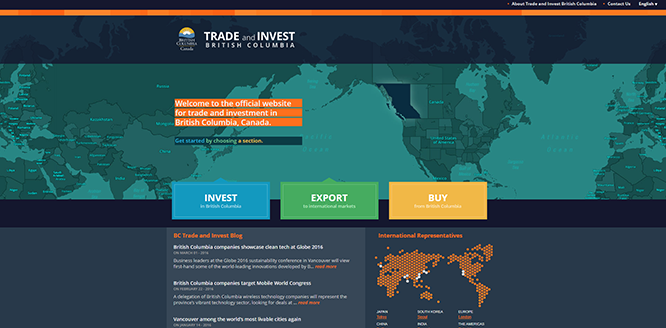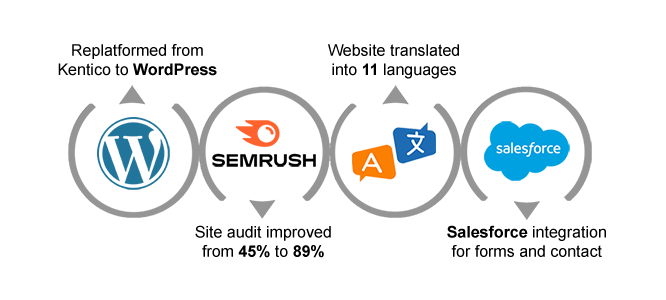Are Governments Providing Improved Digital Experiences During a Global Pandemic?
 Since the start of the pandemic, the phrase “digital-first” has reverberated throughout the business community, with organizations compelled to respond nimbly to prioritize deploying their digital strategies and website assets with a hyper-focus on customers’ online interactions. There’s no questioning the value of a digital-first mindset which can easily be measured in improved efficiency, cost savings, revenue growth, and better overall customer satisfaction. The most significant uptick has been in the IT sector, with a well-documented surge in eCommerce, raising North American retail trade from 14% in 2019 to about 17% in 2020.
Since the start of the pandemic, the phrase “digital-first” has reverberated throughout the business community, with organizations compelled to respond nimbly to prioritize deploying their digital strategies and website assets with a hyper-focus on customers’ online interactions. There’s no questioning the value of a digital-first mindset which can easily be measured in improved efficiency, cost savings, revenue growth, and better overall customer satisfaction. The most significant uptick has been in the IT sector, with a well-documented surge in eCommerce, raising North American retail trade from 14% in 2019 to about 17% in 2020.
While a digital-first strategy has come to be expected in the private sector, what about the public sector? Government bodies have often lagged behind the pace of digital evolution, with an unfortunate reputation for websites that contain dated characteristics and labyrinthine navigation. Governments on all levels had to fortify their pandemic response by taking significant steps forward through digital transformations of their own. The aim was to provide thoughtful, well-planned, and well-executed user experiences to help citizens and private sector businesses quickly access urgent information and find the programs and services they needed as they navigated through an unprecedented human and global economic crisis.
When the people of the world had to isolate themselves from one another physically, the need to remain connected virtually was imperative. Over the last twenty-three months, the public sector has been resolute on delivering digital services at breakneck speed with sites that are secure, reliable, and accessible from any device. Case in point, the Government of British Columbia, Canada, recently launched its new Trade and Invest BC website for the Ministry of Jobs, Economic Recovery and Innovation.
Trade and Invest BC (TIBC) supports international businesses and investors who want to do business in the province by pairing sellers with buyers, connecting investors with opportunities, and bringing together companies seeking talented resources worldwide.
After a preliminary review process by the Ministry of all the vendor proposal responses for the design and development of its new website, TIBC awarded the contract to the IBM Canada (IBM) and Falcon Software Company Inc. (FSC) team. The IBM and FSC partnership is a strategic alliance that brings together two trusted vendors with deep expertise and experience in delivering complex websites through all phases from concept to completion to ongoing support. IBM Canada’s role for the TIBC project was focused on account management, strategic vision, and UX design. FSC’s role was focused on project management, UI design, development, which included coding, setting up infrastructure, creating documentation, and site delivery with ongoing site maintenance.
Identifying the Gaps
The TIBC website (britishcolumbia.ca) was initially designed and implemented in 2013 on the Kentico CMS platform and laid the groundwork for establishing an international, business-oriented online presence. In 2017, TIBC undertook a modernization review. The assessment concluded that the website’s overall design and operating model were outdated and lagged behind other jurisdictions in functionality and user experience, reducing its ability to attract and engage audiences effectively, negatively impacting trade and investment potential.
The report identified the following ten modernization priorities and potential strategies to address them:
- Branding — The website’s look, feel, and messaging were dated and reflected old narratives
- Content — More compelling and engaging content was needed to promote government priorities and deliver key messaging effectively
- Design — The persuasive and engagement elements of the site’s design were dated, resulting in a less than ideal digital user experience
- Mobile — Over 33% of site visits were via smartphones and tablets, yet One Tool, a vital investment attraction feature of the site, did not support mobile device use
- Localization — Human-translated website versions were offered to target three key international markets — China, Japan, and Korea. However, the traffic to these mirror sites was relatively low, and a more cost-effective approach was needed to manage the manually-intensive labour of the sites’ translations
- Data — The site was data-intensive, specifically One Tool, a custom application that published 450,000 statistical data points related to nearly 400 British Columbia communities and associated opportunities. Curating, managing, and publishing this data was time-consuming and very costly
- Visibility — Site visibility was sub-optimal due to poor search engine optimization (SEO) best practices implemented in the original design and build process, resulting in low visitor attraction/acquisition potential
- Engagement, Journeys, and Conversions — While the site had established several conversion paths in its design, it lacked other vital paths related to sectors, business types, and trade and investment services (amongst others). Conversion metrics also needed to be better implemented to measure performance
- Global Deployment — The site was hosted and managed by the B.C. government within the province, but its audience is international. Performance and responsiveness in foreign markets outside of North America were sub-optimal
- Platform Management — The site development and maintenance was costly because numerous application components and complex processes existed that required comprehensive software developer maintenance to manage the site on an ongoing basis, hindering agility and responsiveness
2013 TIBC WEBSITE DESIGN

source:Wayback Machine
Modernization of the Website
Due to the importance, complexity, and budgetary considerations of modernizing the TIBC website, the project was undertaken in multiple phases. Each phase allowed for collaboration with key stakeholders to leverage TIBC’s breadth of knowledge, build upon existing assets, develop new assets, and realize the project goals using a strategic, evolutionary approach.
- Initial Discovery — This phase was a short discovery/knowledge transfer period to align TIBC and the IBM and Falcon Software team on the project goals and scope
- The Design — This phase focused on user personas, user journeys, information architecture, SEO strategies, wireframes, hi-fi mockups, and requirements for the build phase
- The Build — This phase focused on the implementation of an MVP site based on the requirements and hi-fi mockups established in the MVP design, which also included some design improvements to enhance the UI of the site
Delivery of the Project
The IBM and Falcon-Software partnership worked closely and collaboratively with TIBC’s business and technical teams throughout the building and launching of the new website. Content pages were constructed for the new site while the TIBC technical team set up the necessary client environments, including the new production environment. The business area provided an integration environment where all could review features developed in real-time. This integration environment was central in allowing all teams to work through WordPress security hardening. During the development, Falcon Software integrated with the TIBC DevOps process, which allowed the project to transition to a site maintenance workflow post-launch seamlessly.
Prior to launch, the new website was fully tested in the new production environment, which eliminated any surprises on launch day with missing images and non-working features. The website launch itself was simply a coordinated effort of DNS changes and SEO activities.

- Technical Quality — TIBC was very happy with the technical build results. Semrush is now used to track and analyze SEO and performance quality. Initial reports run after launch showed ratings of 89% versus the 45% ratings from the former Kentico site
- Visual Quality – The UI/UX of the new site received positive feedback from senior levels of the government as they introduced the site to groups across the province prior to the official public launch. With TIBC’s marketing team assisting with determining what improvements are needed, continued augmentation efforts by IBM, Falcon Software, and the TIBC team are ongoing to improve all areas of the site
2021 TIBC WEBSITE DESIGN

Visit the new TIBC website
Final Statement
One thing is certain. No matter what your politics, Covid-19 has transformed all our lives. If there is such a thing as a positive side to a pandemic, it’s the shift in effort from governments to embrace the same digital-first mentality that corporations adopted by committing budgets towards implementing meaningful website upgrades and concentrating their efforts to manage those technology assets to keep pace with the public’s demand for robust online services.

Gary Eisenstein
Gary has been working in the IT industry since 1993 and is the Principal Analyst at CMS-Connected, and the Founder and President of Falcon-Software. If you would like advice on how to evaluate a "best-fit" digital experience solution for your organization, Gary can be reached at gary.eisenstein@cms-connected.com.